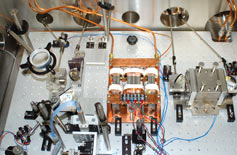
Handy Links
SLAC News Center
SLAC Today
- Subscribe
- Archives: Feb 2006-May 20, 2011
- Archives: May 23, 2011 and later
- Submit Feedback or Story Ideas
- About SLAC Today
SLAC News
Lab News
- Interactions
- Lightsources.org
- ILC NewsLine
- Int'l Science Grid This Week
- Fermilab Today
- Berkeley Lab News
- @brookhaven TODAY
- DOE Pulse
- CERN Courier
- DESY inForm
- US / LHC
SLAC Links
- Emergency
- Safety
- Policy Repository
- Site Entry Form

- Site Maps
- M & O Review
- Computing Status & Calendar
- SLAC Colloquium
- SLACspeak
- SLACspace
- SLAC Logo
- Café Menu
- Flea Market
- Web E-mail
- Marguerite Shuttle
- Discount Commuter Passes
-
Award Reporting Form
- SPIRES
- SciDoc
- Activity Groups
- Library
Stanford
Around the Bay
Laser Creates Extremely Small Electron Bunches
 Using red laser light, experimenters have successfully divided up a standard bunch of electrons into a train of extremely small bunches. This is a positive step toward their overarching goal to accelerate electrons with laser light rather than microwave power.
Using red laser light, experimenters have successfully divided up a standard bunch of electrons into a train of extremely small bunches. This is a positive step toward their overarching goal to accelerate electrons with laser light rather than microwave power.
Laser light has the potential to imbue electrons with an order of magnitude more energy per meter than current microwave-based acceleration, possibly leading to smaller and less expensive accelerators.
In the E-163 experiment conducted last December, graduate student Chris Sears, physicist Eric Colby and the advanced accelerator research team used a red-wavelength laser to divide up 1-picosecond-long electron bunches generated by the Next Linear Collider Test Accelerator in End Station B. The resulting "microbunches" have the right spacing to be accelerated by laser light.
For laser light to transfer most of its energy to electrons, the distance between electron bunches has to match the distance between the laser oscillations—2.3 femtoseconds, or about 1,000 times shorter than a picosecond, which is already only one trillionth of a second. Trying to accelerate picosecond-long electron bunches with visible laser light would be like a surfer on a 3-meter-long surfboard attempting to catch waves spaced a centimeter apart.
"It's all very small," Sears said. "That's the challenge with laser acceleration. It shrinks down the dimensions of everything we're trying to do."
A normal electron bunch—sent through undulator magnets with the laser light and then through a magnetic bend on its own—yields about 500 microbunches spaced 2.3 femtoseconds apart. Each microbunch is only hundreds of attoseconds long (or 10,000 times shorter than the parent 1-picosecond-long bunch).
Researchers proved they had made the attosecond microbunches by slamming them into a thin foil and measuring the wavelength of the resulting radiation.
The 800-nanometer-wavelength laser, which emits dark red light, will ultimately serve two purposes. Each light pulse will be split into two, with half going to break up electron bunches, as Sears demonstrated in December. An experiment planned for early this year will employ the other half of the laser pulse to actually accelerate the microbunches.
—Heather Rock Woods, SLAC Today, January 14, 2008
Above image: The experimental equipment that splits electron bunches into tiny microbunches to be accelerated by laser light.